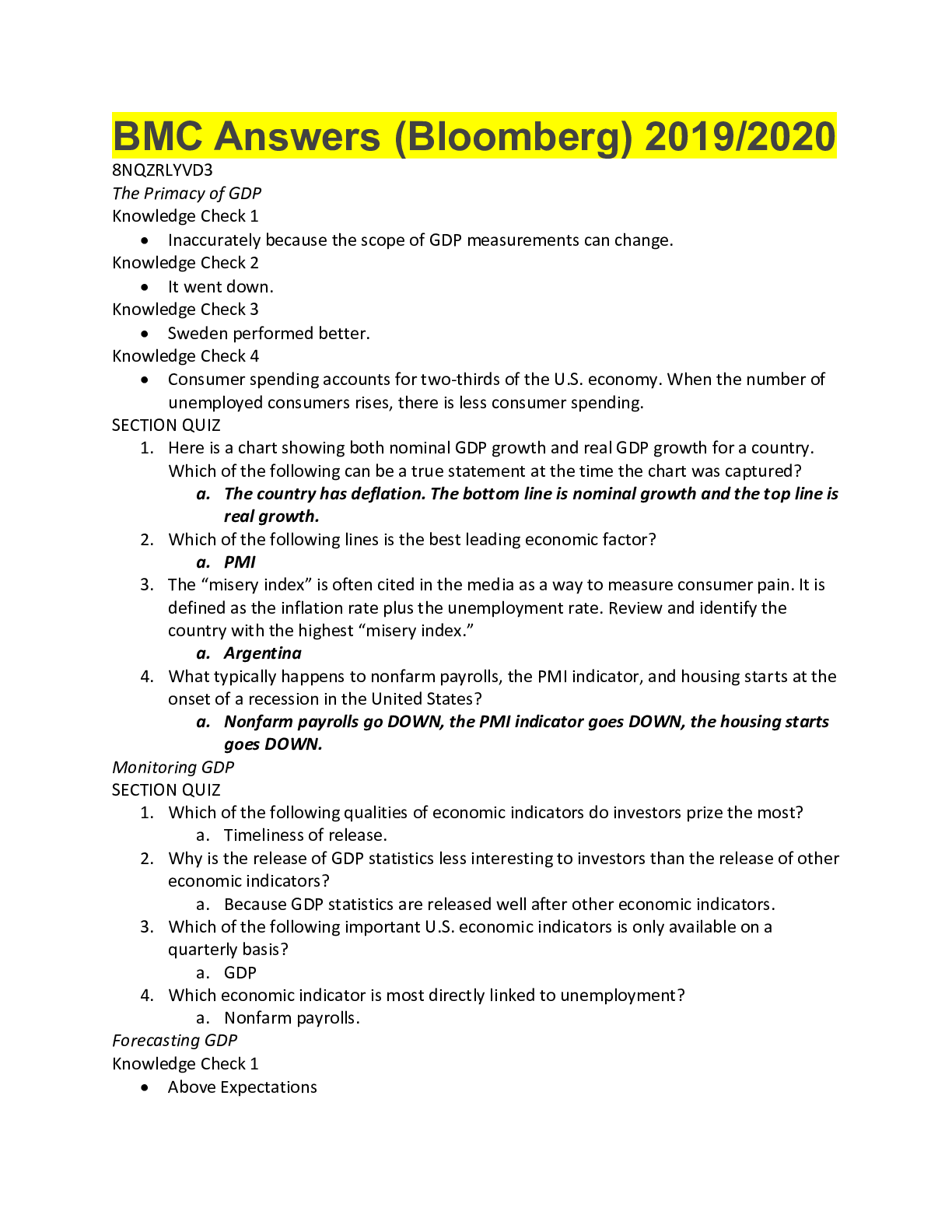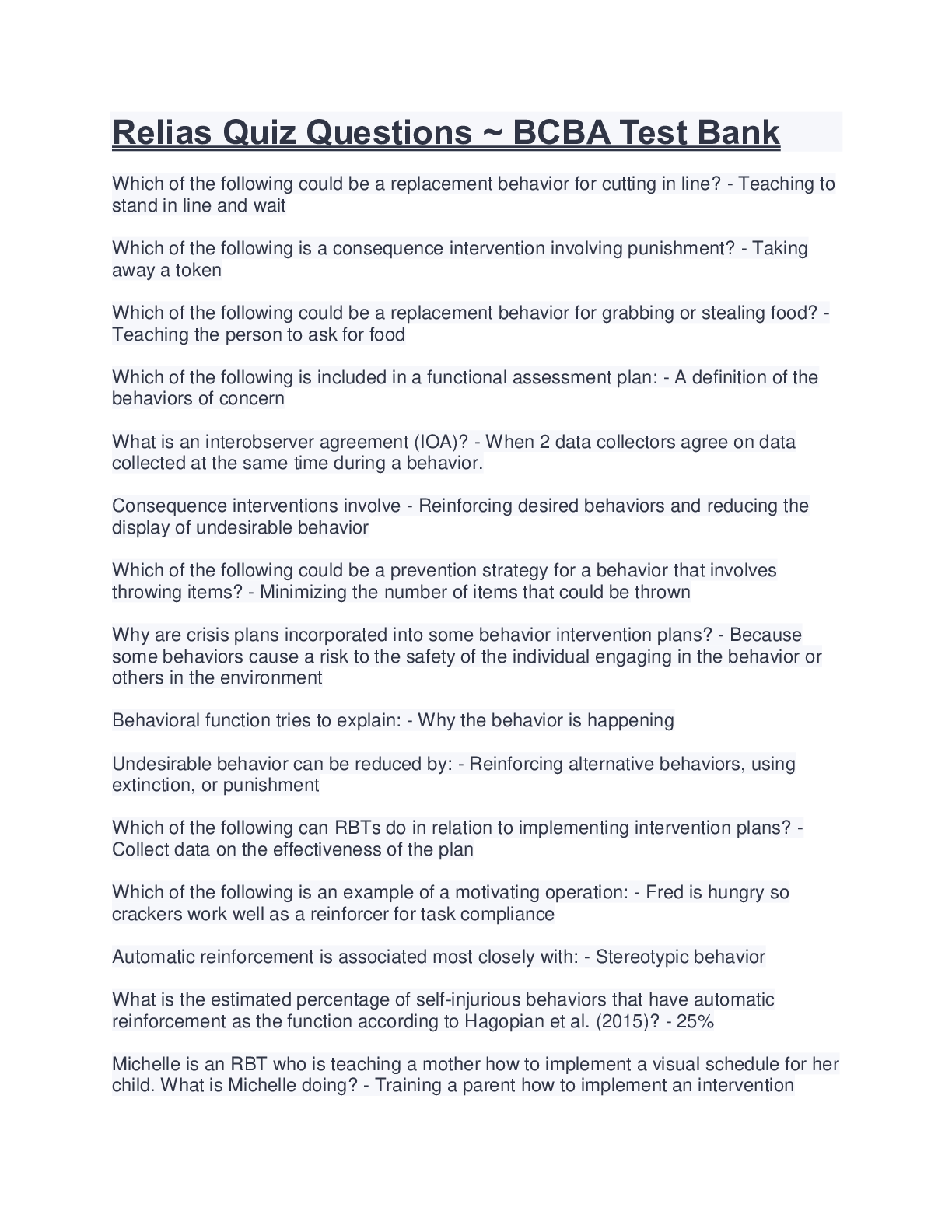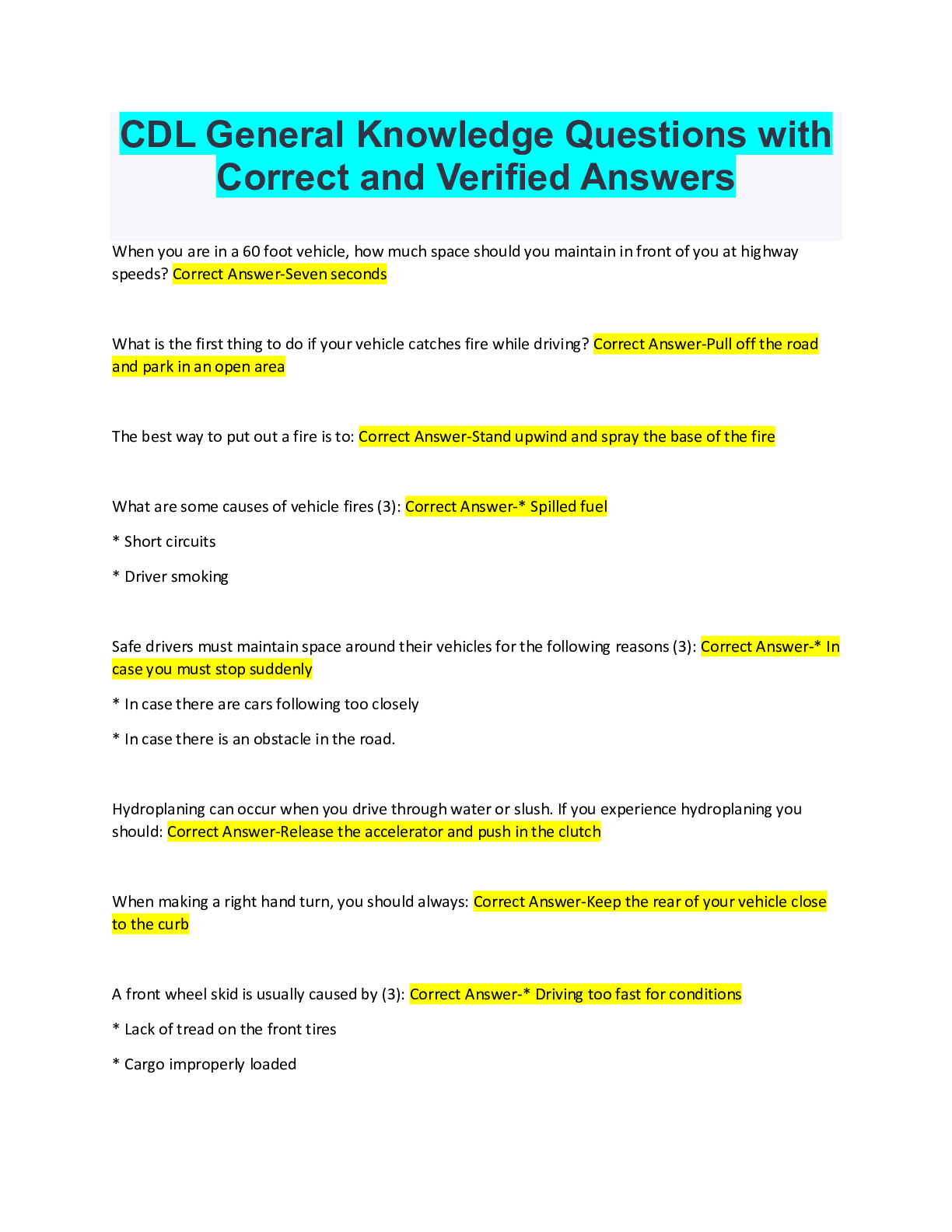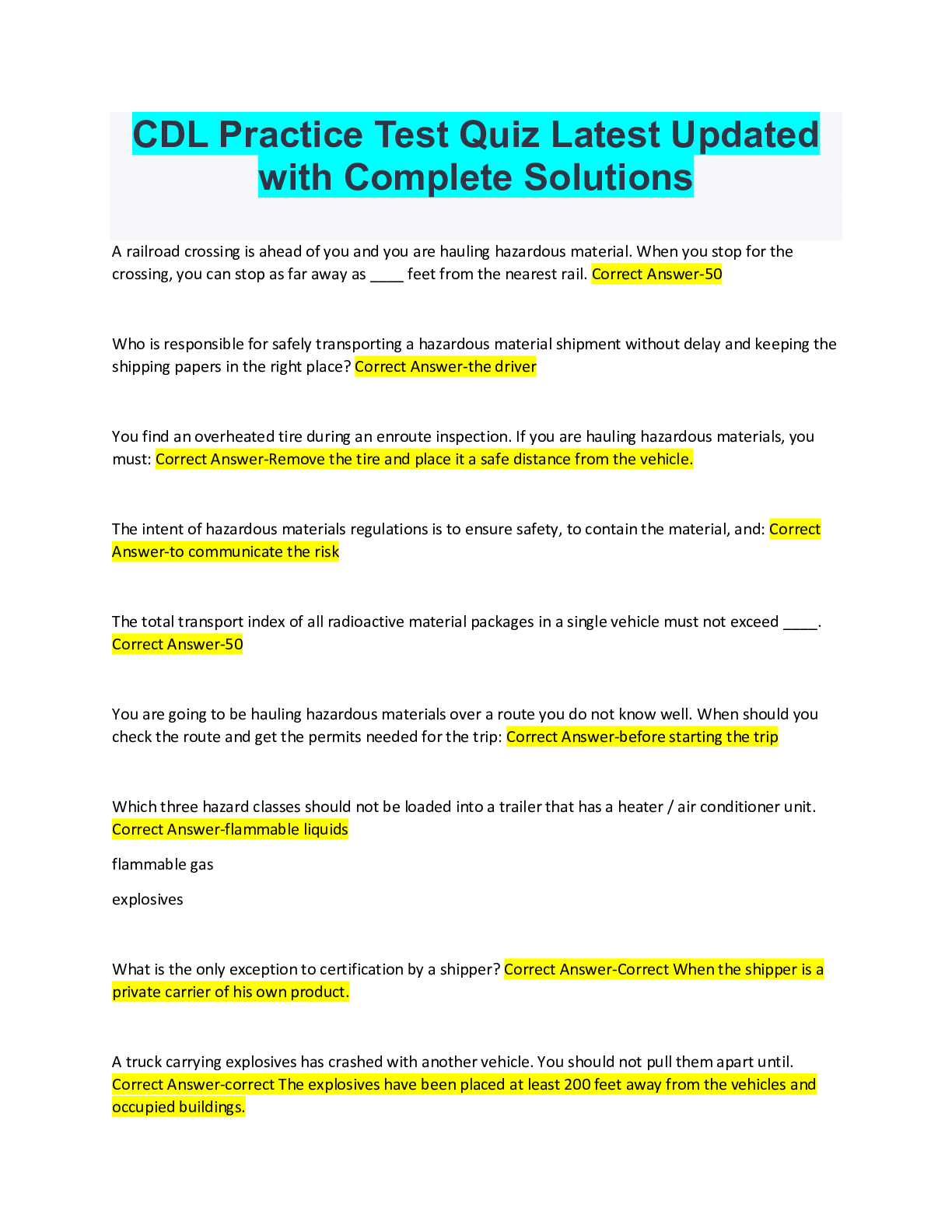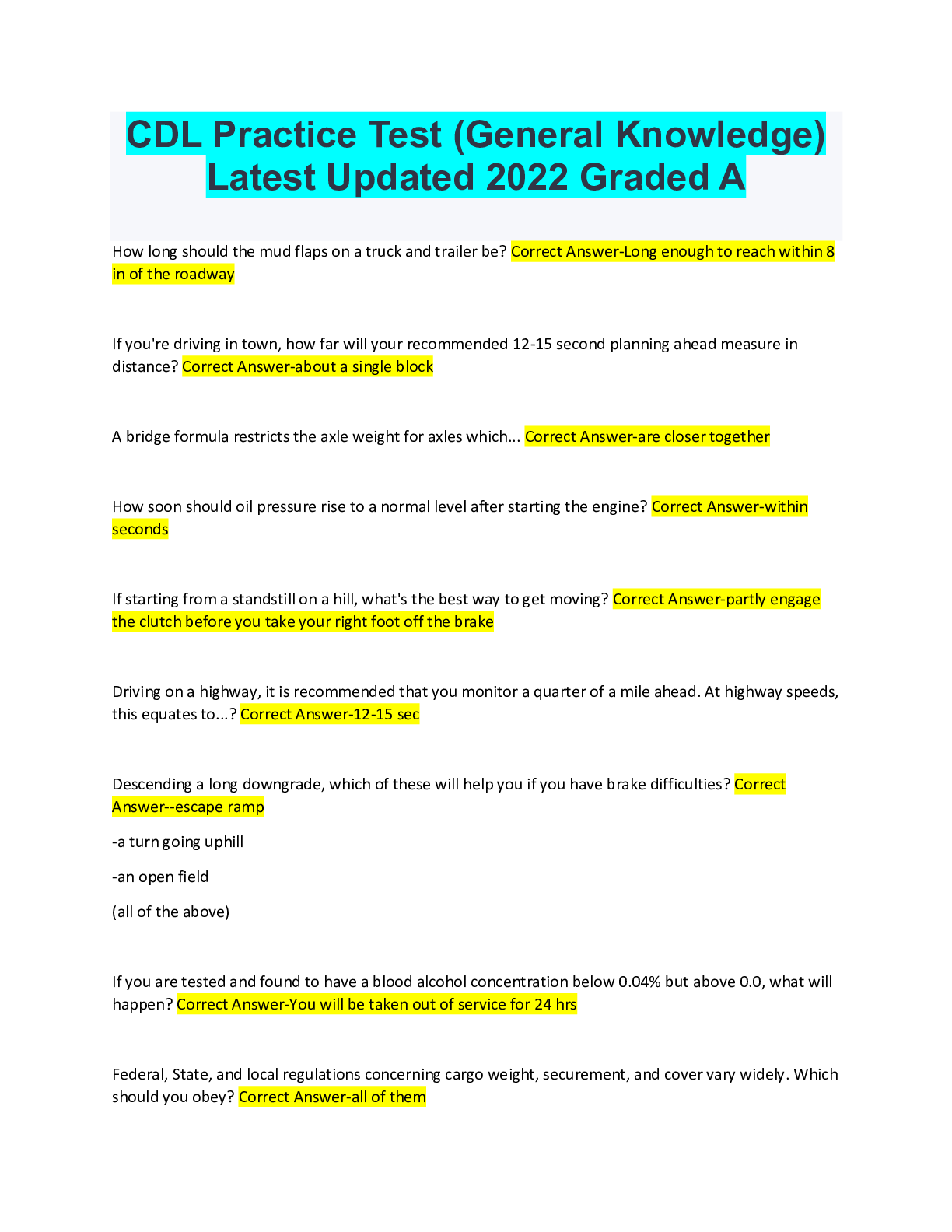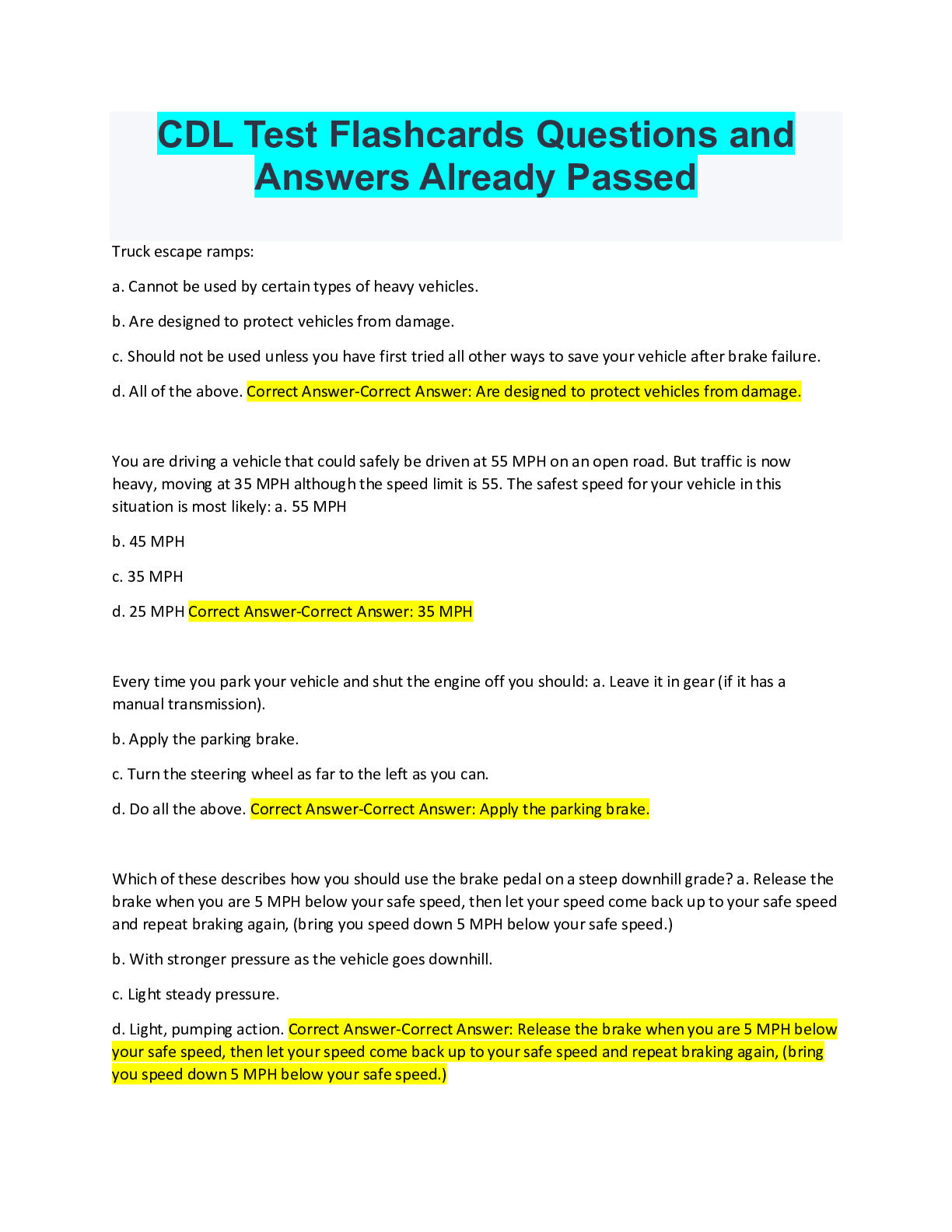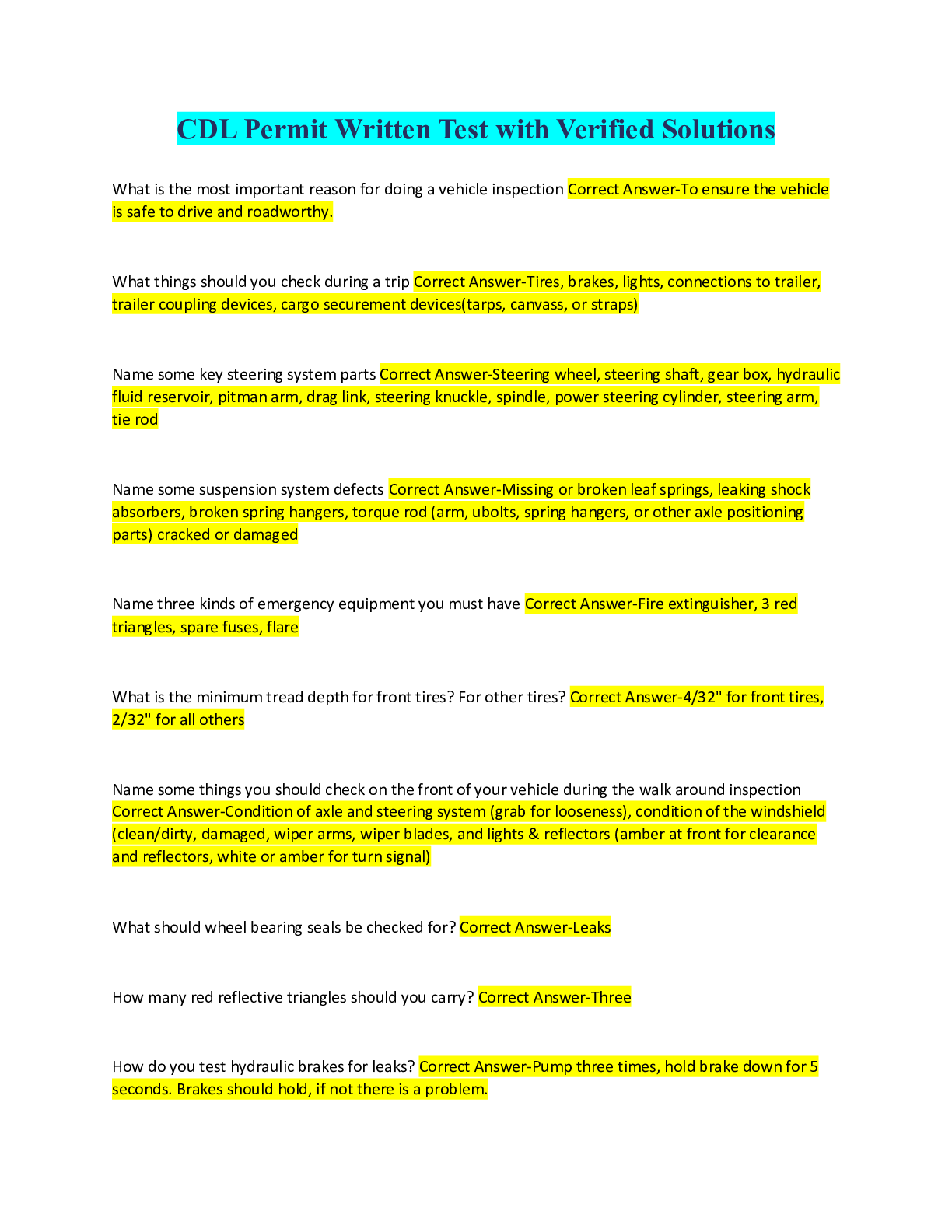*NURSING > QUESTIONS & ANSWERS > PHIL 447N Logic & Critical Thinking Week 8 Final Exam (All)
PHIL 447N Logic & Critical Thinking Week 8 Final Exam
Document Content and Description Below
Multiple Choice Questions Question 1.1. (TCO 1) “Thinking about thinking” is the definition of what? Question 2.2. (TCO 1, 2, 4) In Chapter 1, we learned the definition of the term issue. The pr... inciple concern when handling an issue is whether or not Question 3.3. (TCOs 1, 2, 3) In Chapter 1, we learned the definition of the term argument. The purpose of an argument is to Question 4.4. (TCOs 2, 3) In Chapter 2, we learned the meaning of inductive arguments. The support that the premises provide for the conclusion of an inductive argument is best described in terms of Question 5.5. (TCO 1, 2) In Chapter 2, we learned the meaning of the three modes of persuasion, as defined by Aristotle. Logos refers to arguments based on Question 6.6. (TCO 6) In Chapter 2, we learned how to analyze arguments. The first step in trying to understand arguments is to find the Question 7.7. (TCOs 6, 7, 8, 9) In Chapter 3, we learned about the key elements of an argumentative essay. An author of a good argumentative essay should do all of the following, EXCEPT Question 8.8. (TCOs 6, 8, 9) In Chapter 3, we learned the meaning of ambiguity and the difference between semantic and syntactic ambiguous claims. Consider the following example: “Students at DeVry enroll in thousands of courses every semester.” In this statement, the ambiguity used is Question 9.9. (TCOs 2, 6, 7, 8) In Chapter 4, we learned how to assess the credibility of claims. A disinterested party who makes a claim is one who Question 10.10. (TCOs 1, 6, 7, 9) In Chapter 5, we learned that it is important to recognize when a rhetorical slanting device is being used to influence our attitudes and beliefs. The purpose of the rhetorical device called a dysphemism is to replace a term with a(n) _____ meaning with one that has a(n) _____ meaning. Question 11.11. (TCOs 1, 7) In Chapter 5, we learned that it is important to recognize when a rhetorical slanting device is being used to influence our attitudes and beliefs. The purpose of the rhetorical device called a proof surrogate is to suggest a claim’s truth based on Question 12.12. (TCOs 1, 2) In Chapter 6, we learned that it is important to recognize when a fallacy of relevance is being used to influence our attitudes and beliefs. A personal ad hominem fallacy is an attack Question 13.13. (TCOs 6, 7, 8) In Chapter 6, we learned that which party is responsible for the burden of proof depends upon a number of factors. All things being equal, the burden of proof falls automatically on the party taking Question 14.14. (TCOs 1, 2) In Chapter 11, we learned how to evaluate arguments from analogy. The best way to demonstrate the weakness of an argument form analogy is to show that the analogues are Question 15.15. (TCOs 3, 4) In Chapter 9, we learned the basics of categorical logic. Each standard-form of categorical logic has its own graphic illustration known by what name? Question 16.16. (TCOs 3, 4, 8, 9) In Chapter 9, we learned the basics of Categorical Logic. Two claims can be equivalent, if and only if, under the same circumstances Question 17.17. (TCOs 2, 3, 4) In Chapter 9, we learned that the square of opposition is a graphic illustration of the relationship between the four standard-form categorical claims. In the square of opposition, the sub contrary claims are those where Question 18.18. (TCOs 2, 3, 4) In Chapter 9, we learned the basics of categorical logic, including three categorical relations: conversion, contraposition, and obversion. Contraposition involves replacing the standard terms with _____ terms. Question 19.19. (TCOs 2, 5) In Chapter 11, we learned how to evaluate inductive generalizations based on samples. The purpose of studying samples is to generalize from Question 20.20. (TCOs 2, 5) In Chapter 11, we learned how to evaluate inductive generalizations based on samples. The range of variation from one sample to another is known as Question 21.21. (TCOs 1, 5, 8, 9) In Chapter 7, we learned how to recognize fallacies of induction. The fallacy of hasty generalization results from a sample that is not _____ to represent the population. Question 22.22. (TCOs 1, 2, 3) In Chapter 11, we learned about the meaning and function of three principles of causal hypotheses. The common variable principle states a variable related to multiple occurrences may be Question 23.23. (TCOs 2, 6) In Chapter 12, we learned the difference between religious relativism and religious absolutism. The guiding principle of religious relativism is the theory that what is right and wrong is based on the beliefs of Question 24.24. (TCOs 2, 6) In Chapter 12, we learned the difference between moral relativism and moral absolutism. According to moral relativism, the idea of right or wrong is based on Question 25.25. (TCOs 1, 6) In Chapter 12, we learned about the consistency principle, which states in part that, “If separate cases are not different in any relevant way, then they should be treated Essay Questions Question 1.1. (TCOs 3, 6, 7, 9) Here is a passage that contains a rhetorical fallacy. Name the fallacy, and in a paragraph, explain why the argument is irrelevant to the point at issue. Here is your example for this question: An editorial says, “Taxes have jumped by more than 30% in just two years! The governor is working for a balanced state budget, but it’ll be on the backs of us taxpayers; the people who have the very least to spend! It seems pretty clear that these increased taxes are undermining the social structure in this state. Anybody who isn’t angry about this just doesn’t understand the situation and hasn’t figured out just how miserable they are.” Question 2.2. (TCOs 5, 8) In the example below, identify the presumed cause and the presumed effect. Does the example contain or imply a causal claim, a hypothesis, or an explanation that cannot be tested? If it does fall into one of those categories, tell whether the problem is due to vagueness, circularity, or some other problem of language. Also, tell whether there might be some way to test the situation, if it is possible at all. Here is your example: Our class instructor has blue eyes, because she had them in a previous incarnation. Question 3.3. (TCOs 2, 4) Explain in what way the thinking of the following statement is wrong or defective. Give reasons for your judgment. There must be something to palm reading. Millions of people believe in it. Question 4.4. (TCOs 3, 9) Moral relativism is the belief that what is right or wrong may differ from group to group, or culture to culture. What are the difficulties of moral relativism? Question 5.5. (TCOs 6, 7, 9) Here is a short essay about an investigation. Scientists have learned that people who drink wine weekly or monthly are less likely to develop dementia, including Alzheimer’s disease. (Daily wine drinking, however, seems to produce no protective effect.) The lead researcher was Dr. Thomas Truelsen of the Institute of Preventive Medicine at Kommunehospitalet in Copenhagen. The researchers identified the drinking patters of 1,709 people in Copenhagen in the 1970s and then assessed them for dementia in the 1990s, when they were age 65 or older…………… People who drank beer regularly were an increased risk of developing dementia. -adapted from BBC News Online There are also four questions/tasks; write a paragraph to answer each one of them. (1) Identify the causal hypothesis at issue. (2) Identify what kind of investigation it is. (3) There are control and experimental groups. State the difference in effect (or cause) between the control and experimental groups. (4) State the conclusion that you think is warranted by the report. Question 6.6. (TCOs 3, 4, 6) Read this passage below. When you have done so, answer these three questions, writing a paragraph for each question. Another quality that makes [Texas Republican and former Congressman] Tom DeLay an un-Texas politician is that he’s mean. By and large, Texas pols are an agreeable set of less-than-perfect humans and quite often well-intentioned. As Carl Parker of Port Arthur used to observe, if you took all the fools out of the [Congress], it would not be a representative body any longer. The old sense of collegiality was strong, and vindictive behavior punishing pols for partisan reasons was simply not done. But those are Tom DeLay’s specialties, his trademarks. The Hammer is not only genuinely feared in Washington, he is, I’m sorry to say, hated. -excerpt from a column by Molly Ivins, Ft. Worth Star-Telegram (1) What position does the author take on the issue at hand? (2) If the author is supporting a position with an argument, restate the argument in your own words. (3) What rhetorical devices does the author employ in this text? Question 7.7. (TCOs 7, 8) Read this passage below. When you have done so, answer the question in at least one full paragraph, giving specific reasons. Elizabeth has a paper due tomorrow morning. She has tried to write something for hours, but has no ideas for a good paper. Elizabeth remembers that her sorority sister, Deb, said that Elizabeth could use any of Deb’s papers in their sorority house computer…………..Elizabeth feels confident that she has Deb’s permission to do this. Is Elizabeth guilty of plagiarizing? Your three questions are as follows. (1) What premises is the author using? (2) What conclusions does the author come to? (3) Are the conclusions justified? [Show More]
Last updated: 1 year ago
Preview 1 out of pages

Reviews( 0 )
Document information
Connected school, study & course
About the document
Uploaded On
Sep 23, 2020
Number of pages
Written in
Additional information
This document has been written for:
Uploaded
Sep 23, 2020
Downloads
0
Views
2

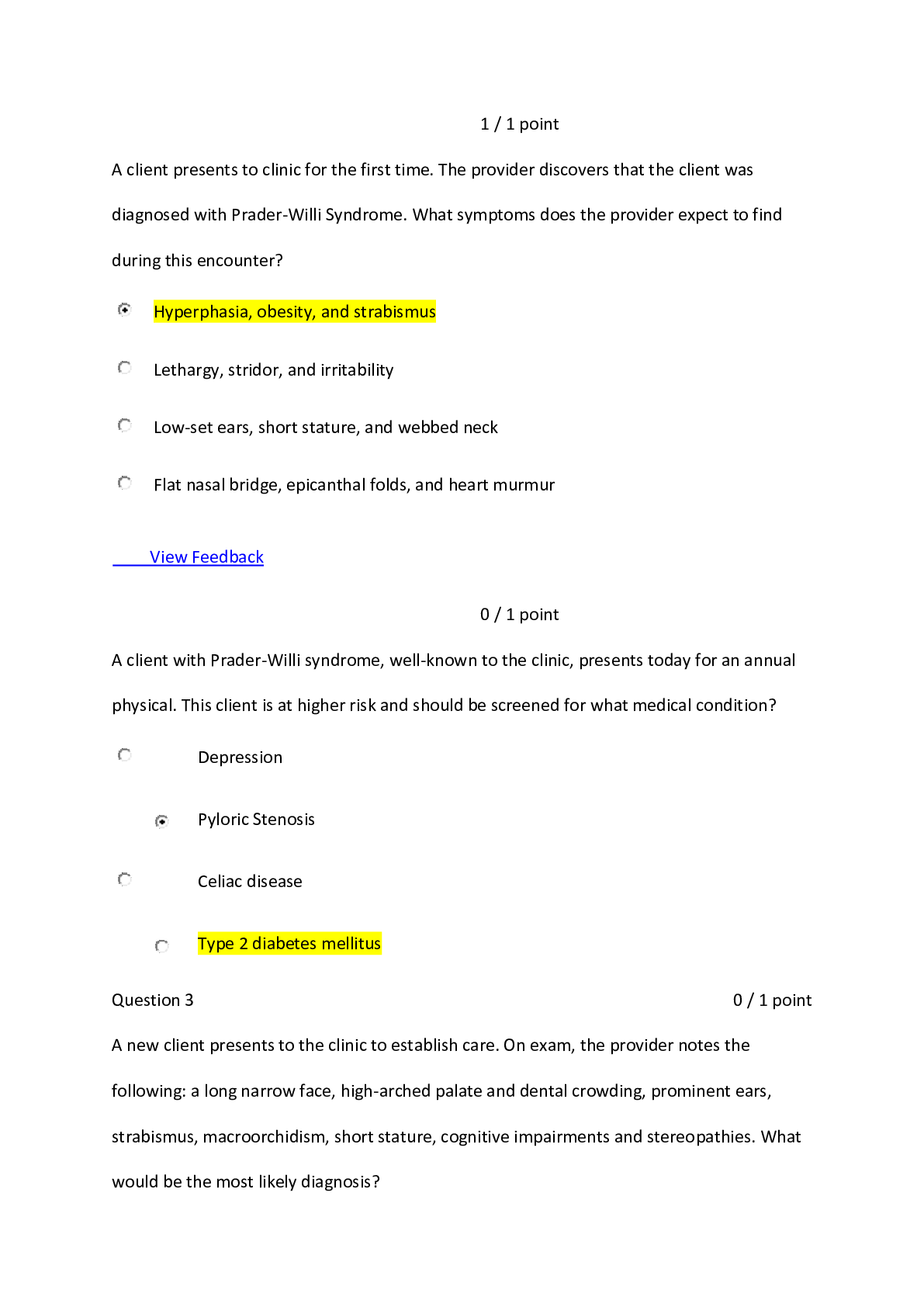
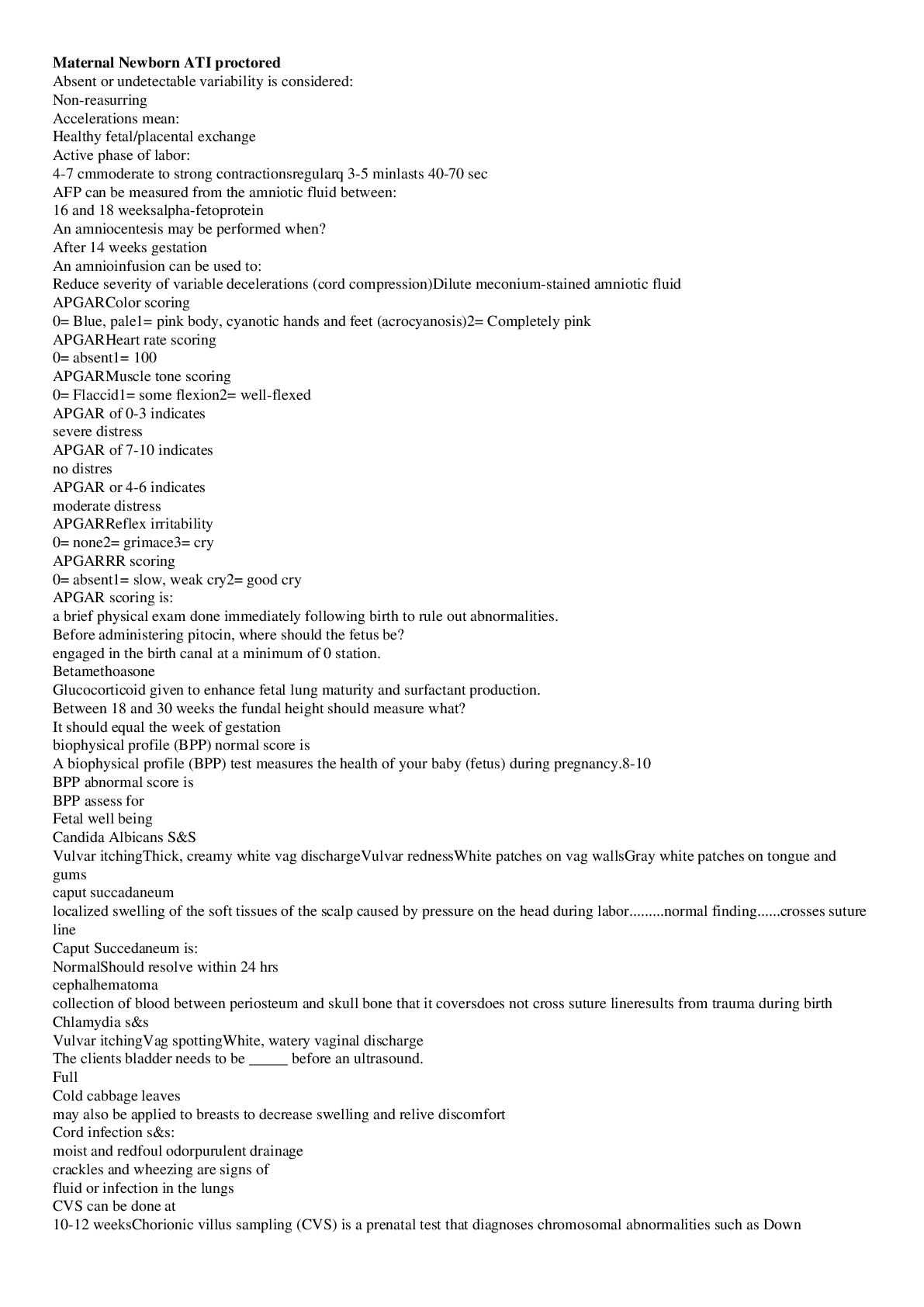
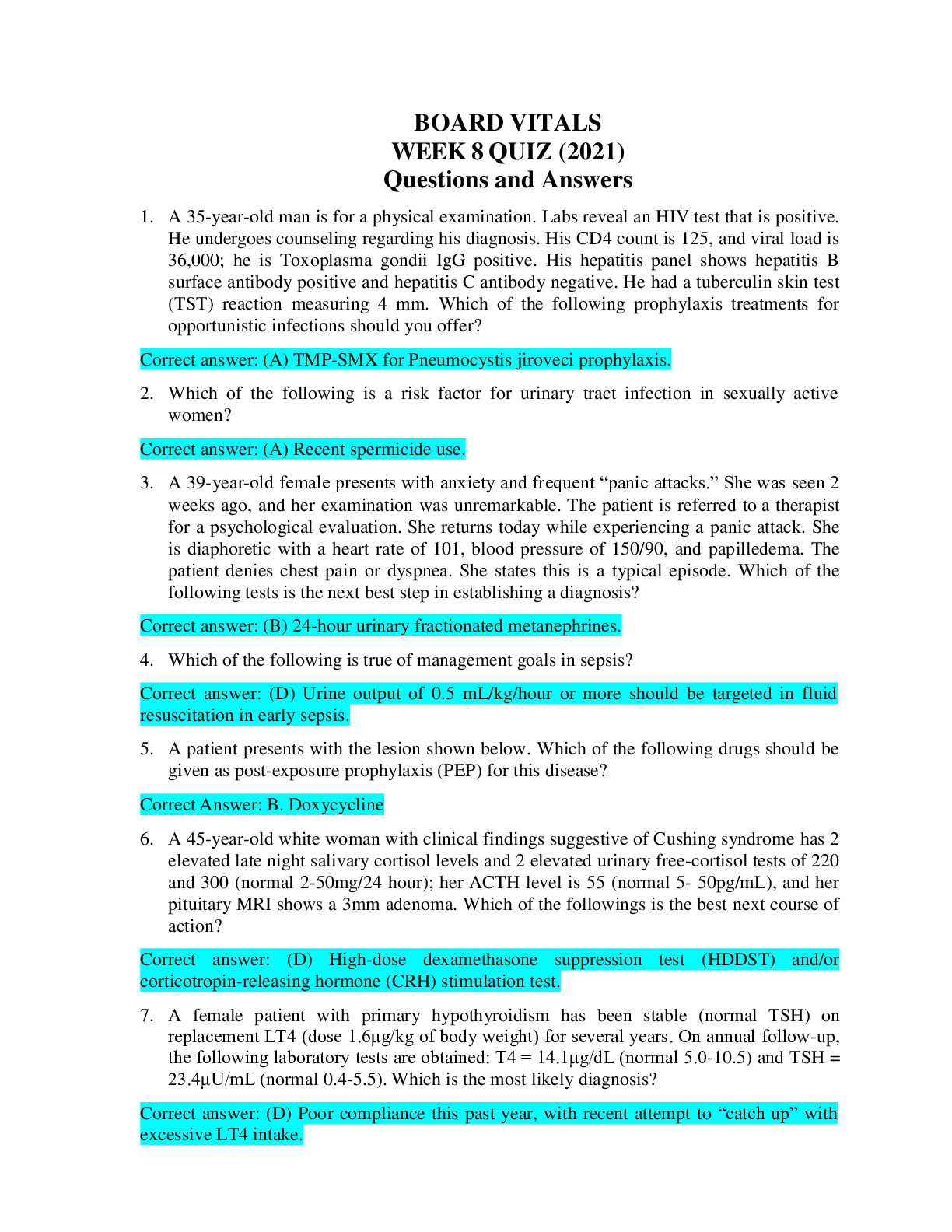

, (A Grade), Questions and Answers, All Correct Study Guide, Download to Score A.png)
 (LATEST-2021) CORRECT ANSWERS, DOWNLOAD TO SCORE A.png)
, Latest Questions and Answers with Explanations, All Correct Study Guide, Download to Score A.png)
 110 OUT OF THE 160 TOTAL QUESTIONS FOR EACH VERSION AUTHENTIC Questions and Answers (latest Update), Correct, Download to Score A.png)
, Latest Questions and Answers with Explanations, All Correct Study Guide, Download to Score A.png)
, Latest Questions and Answers with Explanations, All Correct Study Guide, Download to Score A.png)
 (Verified Answers, COMPLETE GUIDE FOR EXAM PREPARATION).png)
, Questions and Answers, All Correct Study Guide, Download to Score A.png)
 (LATEST-2021) CORRECT ANSWERS, DOWNLOAD TO SCORE A.png)
, Latest Questions and Answers with Explanations, All Correct Study Guide, Download to Score A.png)
 All Correct Answers, Download to Score A.png)
, Latest Questions and Answers with Explanations, All Correct Study Guide, Download to Score A.png)
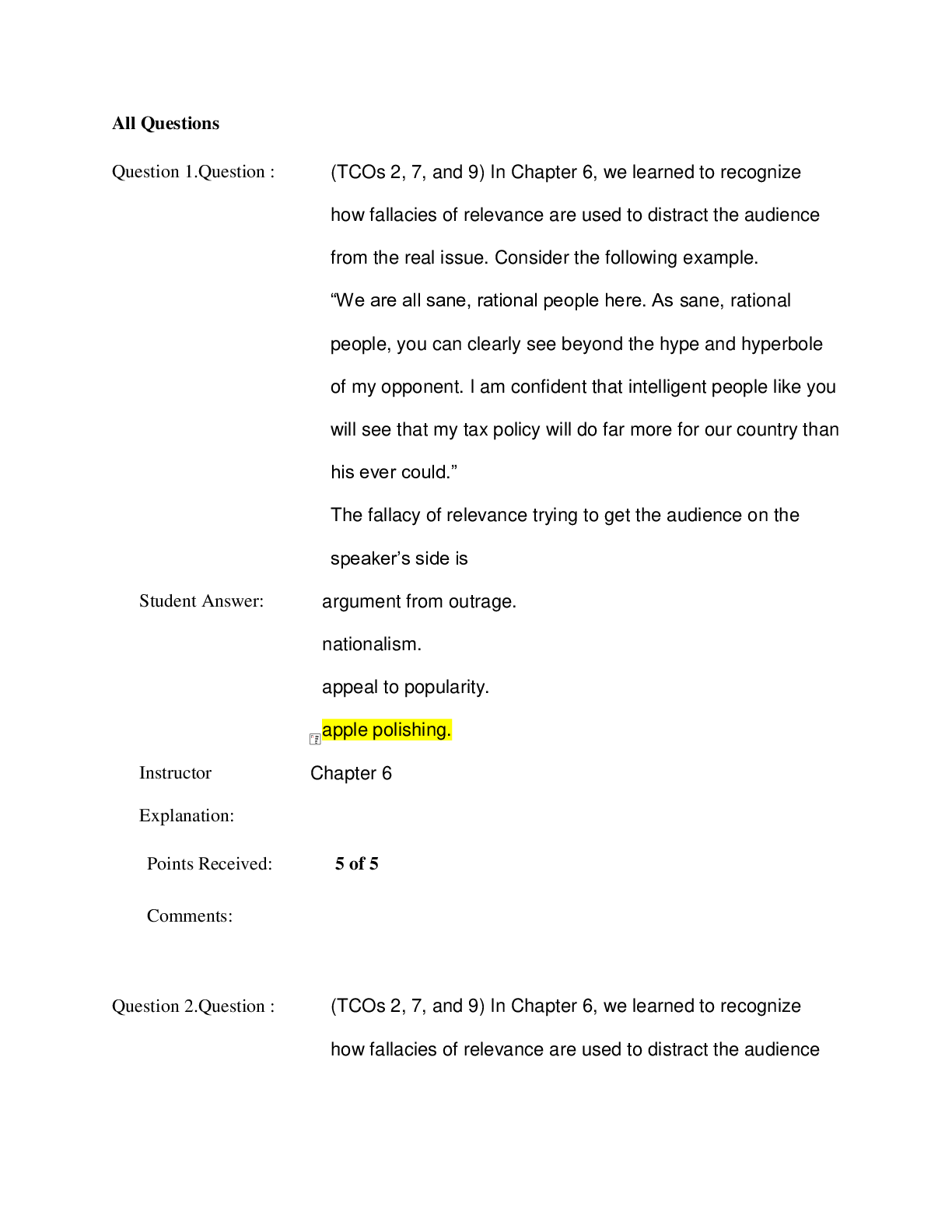
.png)
